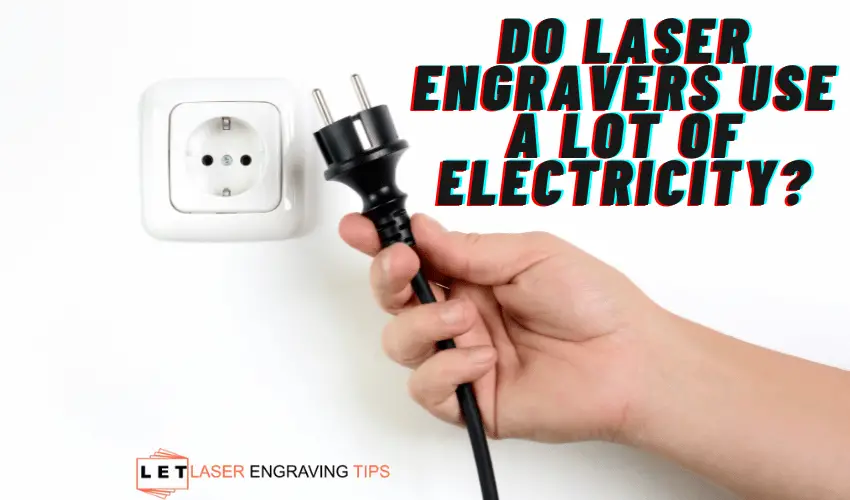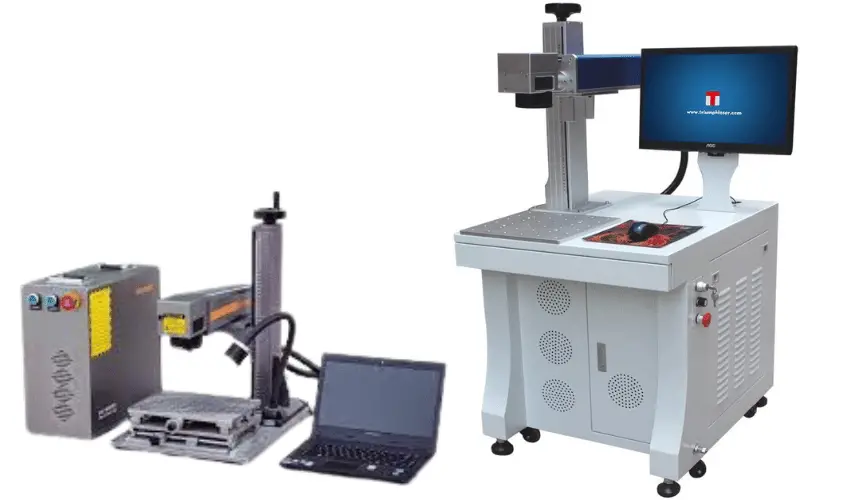Laser engravers are a machine that uses lasers to create markings or designs on different types of surfaces. They are commonly used to mark or etch logos, text, and other designs onto products. But do laser engravers use a lot of electricity?
The electricity required will depend on the model of laser engraver you have, the power used, and the type of materials being engraved, but generally, a 40 Watt CO2 laser engraver with an extraction fan, air pump, and chiller will use around 370 Watts of power, while a 20 Watt fiber laser engraver uses around 240 Watts of power and a 10 Watt Diode laser engraver uses around 60 Watts of power.
In this blog post, I will look at how much power laser engravers consume and whether or not they are a major contributor to your monthly energy bill.

How Much Power Do CO2 Laser Engravers Use?
A 40 Watt CO2 laser engraver typically uses around 370 Watts of power when running. This includes the electricity required to power the laser, air pump, water chiller and the PC used to control it. Additionally, a extraction fan is also needed to keep the machine from overheating and included in the above calculation.
Example:
Laser equipment with an 80W laser output and used on a daily average of 2 hours.
The maximum laser power (80W) is used for 50% of the working time, and 50% of the remaining time is spent using half of the laser power (40W).
As a result, there is a very low energy use of only 50 kWh per month, which is equal to using two office PCs.
How Much Power Do Fiber Laser Engravers Use?

A 20 Watt fiber laser engraver typically uses around 240 Watts of electricity when running, but this number can be slightly higher or lower depending on the model of machine you have and the materials you are engraving. As with CO2 laser engravers, a cooling fan is also needed to keep the machine from overheating and will require additional electricity.
Fiber lasers are far more energy-efficient than CO2 lasers.
Have a look at our fiber laser engraver buying guide: Best Fiber Laser Engraver for You
How Much Power Do Diode Laser Engravers Use?

A diode laser engraver’s general power consumption of the whole device is usually 5 – 6 times more than the laser output.
Example:
The Makeblock xTool D1 10 Watt Laser Engraver will use around 50 – 60 Watts of power which is incredibly low and wont make much of an impact on your electricity bill.
Diode Lasers are the most energy efficient lasers.
Have a look at our Diode Laser buying guide here: The Best 10W Diode Laser Engravers
Factors That Affect How Much Power a Laser Engraver Uses

Now that you know how much power a laser engraver can use, it’s important to note that this number can vary depending on the following factors:
Actual Working Time
The actual working time is the amount of time the laser will take to perform the cutting engraving process.
Used Laser Power
The laser power used is the amount of laser power your engraver consumes while cutting or engraving. This number can vary depending on the type of material and design you’re working with, so it’s important to consider this when calculating your electricity usage.
Peripheral Equipment
Using any additional equipment with your laser engraver, such as an extractor fan, will also increase the amount of electricity it uses.
Size of the Engraved Area
The size of the area being engraved can impact the amount of power your laser engraver consumes. Larger areas require more power to engrave and can increase the amount of electricity used.
The Size of Your Machine
Laser engravers vary in size; some are small and portable, while others can be quite large. Generally speaking, the bigger the laser engraver is, the more power it will require to run.
The Type of Material You’re Engraving On
Different materials require different levels of power to be successfully engraved. For example, aluminum requires more energy than wood, and laser engravers will use more power if they engrave on a material that requires a higher energy level.
The Power Settings
You can set the power settings on your laser engraver to use more or less electricity. When you are using a high-power setting, the machine will use more electricity, and vice versa.
The Frequency of Use
When you are using your laser engraver frequently, it will use more power than when you are not using it. So if you plan on using the machine often, make sure to factor in this additional electricity usage.
How to Use Your Laser Engraver Effectively

While laser engravers are energy efficient, here are a few steps you can take to ensure you are using your machine as efficiently as possible:
Check Power Settings
You should ensure the power settings are set at the correct level for your specific material and design. This will help to ensure that you are using the minimum amount of power required to get the job done.
Turn it Off When Not in Use
When you’re not using your laser engraver, make sure to turn it off. Doing so will reduce the amount of electricity you are consuming and help save energy.
Use Cooling Fans
Cooling fans can help reduce the amount of electricity your laser engraver uses. By keeping your machine cool, you’ll be able to get more work done in less time and use less power overall.
Regularly Clean Your Laser Engraver
Regularly cleaning your laser engraver will help ensure it runs at peak performance. This means that your machine won’t be using more power than necessary, helping you save energy in the long run.
Also Read: How much does it cost to run a laser cutter?
Do Laser Engravers Use A Lot Of Electricity: FAQs
How much power does a laser engraver use?
The amount of power a laser engraver uses depends on various factors, such as the actual working time, the type of material being engraved, and the size of the machine. Generally speaking, most machines require between 50-500 watts when running.
Is laser engraving energy efficient?
Yes, laser engravers are very energy efficient when used correctly. By setting the power settings correctly and turning it off between jobs, you can ensure that your machine uses as little energy as possible.
How much does a laser cost to run?
The cost to run a laser engraver depends on the machine’s wattage and how often you are using it. Generally speaking, running an average-sized machine for an hour cost around $0.50 – $1.00 USD in electricity.
Final Thoughts
Laser engravers can be very energy efficient if used correctly. Considering the various factors mentioned above, you can ensure that your machine uses as little power as possible while still getting the job done.
Ultimately, this will help to keep your electricity bill in check and save you money in the long run. I hope this article has helped you understand the power requirements of laser engravers.
